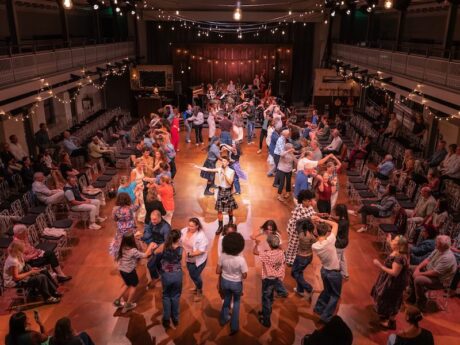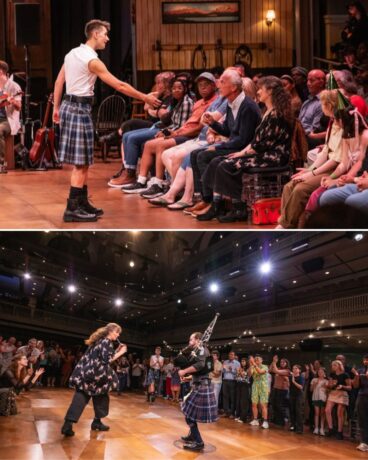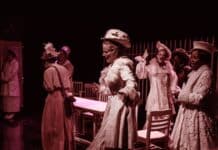Picture twinkling stars above the Scottish countryside, a six-piece band playing lively tunes, glasses of whisky with which to raise a toast, two sets of bagpipes, an abundance of tartan, singing, dancing, laughter in every corner of the room, and a sea of confused Americans trying to keep up. Directed by Sam Pinkleton (Broadway’s Oh, Mary!), the North American premiere of Ceilidh has furiously swept into Baltimore, and it’s pure dead brilliant.
If you don’t know what a “ceilidh” is, then chances are you’ve just now mispronounced the word as well. A ceilidh (KAY-lee) refers to a traditional Scottish social gathering involving dancing, music, and storytelling. In Scott Gilmour and Claire McKenzie’s aptly-titled musical (now playing at the M&T Bank Exchange through October 12), audiences are quick to learn of this age-old tradition. However, the Gaelic origins of a ceilidh actually point to something much simpler: in Gaelic, “céle” means “companion.” Part musical fable and part social dance, Ceilidh is about the connections we forge with one another, be they over one fleeting moment or across an entire lifetime.

Gilmour and McKenzie have crafted an intergenerational story about music, love, and community — all of which tenets lie at the heart of every ceilidh. The plot follows a young man named Ramsay MacLavaney (played by Gilmour) and his father, a legendary ceilidh caller named Leo. Their family comes from a long line of callers as foretold by a raucous little ditty called “The MacLavaney’s.” According to this musical, a good caller can ensure the synchronicity and togetherness of the ceilidh, no matter how much or how often the dance moves themselves may change.
Still, there is no point to a ceilidh without an invitation to take part. Much more than a traditional musical, Ceilidh compels audiences to join them in the round. The performers — thankfully — do not pressure audience members into dancing. It is nevertheless difficult to resist their outstretched arms, which beckon us to join in the merriment full force. With the help of several ensemble members, Ramsay and Leo alternatively call live dances during the show, including but not limited to “The Military Two Step,” “The Canadian Barn Dance,” and the “St. Bernard’s Waltz.” These traditional Scottish dances have been passed down through generations and adapted for the show by the creative team. As we are reminded early on, no one has ever looked “cool” dancing a ceilidh, and while much fun can be had from the peanut gallery, this critic strongly encourages all to join in the “called” dance numbers if they are able.
Gilmour as Ramsay impressively balances narration and direct address to the audience, while also shouldering the emotional crux of the evening as he tells his father’s story. Euan Morton brings natural charisma to the role of Leo, a respectable young man whose warmth and humility resound throughout his son’s memories. Courtney Bassett plays Euna, a witty and “bonny” young woman from England who is quickly won over by the ceilidh tradition — and its finest caller, Leo. Her rapturous performance of “The Thistle and the Rose” secures Leo’s heart, not to mention that of all of us lucky enough to witness her performance. The couple’s older counterparts are played by George Drennan and Annie Grace. Mindful of spoilers, it is safe to say their story comes to a heartfelt and deeply satisfying conclusion.

Emma McGlinchey and Charlie West are hilarious as a pair of wily Scots whose wedding serves a pivotal plot purpose for the main couple. A gifted fiddle player, Rori Hawthorn later plays McGlinchey and West’s daughter. With each cast member taking on several smaller roles, Anne L. Nathan portrays Leo’s smack-talking granny, while David Rowen steps in as Ramsay’s first and only love, Lucas. Recognizing the two men’s connection for what it is, Leo and Euna welcome Lucas into their family with open arms and a tactfully choreographed couple’s hold (“It’s All About the Hold”). Therein lies the musical’s simple yet powerful message: “Love does what love does, and who are we to question it?”
String lights line the vaulted ceiling of the M&T Bank Exchange’s unique event space, while the room is bedecked with kitschy allusions to Scottish heritage past and present. With cheeky costume pieces, kilts, and modern dress, Sarah Laux’s costume design encapsulates a dry but gleeful sense of humor not unfamiliar to that of one of the musical’s most well-known producers, Alan Cumming. While scenic designer Rachel Hauck has primarily commandeered the venue for the social dance portion of the evening, Isabella Byrd’s lighting design ushers us into near and distant memories.
Deceptively simple in its conceit, Ceilidh is unlike anything you might catch on Broadway or elsewhere this fall. For DC theatergoers hesitant to travel to Baltimore for this production, I have but one bit of advice: find yourself a hand to hold because, with so much love about this musical — and so many places to find love within it — the journey proves well worth the price of the trip.
Running Time: Two hours and 30 minutes, including one intermission.
Ceilidh plays through October 12, 2025, at M&T Bank Exchange at the France-Merrick Performing Arts Center, 401 W Fayette Street, Baltimore, MD. For tickets (starting at $45), purchase them online. Learn more here.
The program is online here. Cast and creative credits are here.



